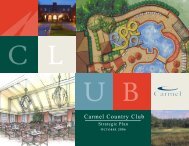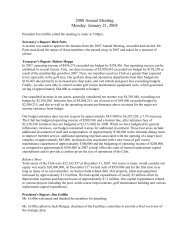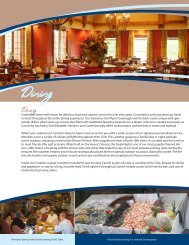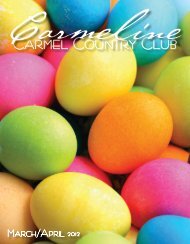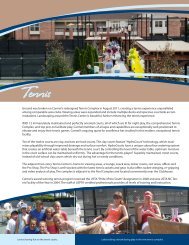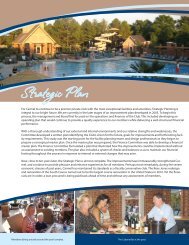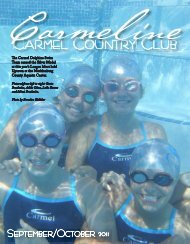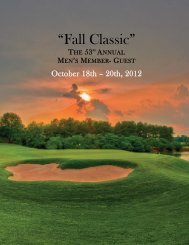Click here for Carmel's - Carmel Country Club
Click here for Carmel's - Carmel Country Club
Click here for Carmel's - Carmel Country Club
You also want an ePaper? Increase the reach of your titles
YUMPU automatically turns print PDFs into web optimized ePapers that Google loves.
<strong>Carmel</strong> <strong>Country</strong> <strong>Club</strong><br />
4735 <strong>Carmel</strong> Road<br />
Charlotte, North Carolina 28226<br />
www.carmelcountryclub.org
<strong>Carmel</strong> <strong>Country</strong> <strong>Club</strong><br />
The South Course<br />
2011
“This is a true multiple option golf course.”<br />
- South Course Architect Rees Jones, March 30, 2011<br />
<strong>Carmel</strong> <strong>Country</strong> <strong>Club</strong><br />
4735 <strong>Carmel</strong> Road<br />
Charlotte, North Carolina 28226<br />
www.carmelcountryclub.org
On March 30, 2011 <strong>Carmel</strong> <strong>Country</strong> <strong>Club</strong>’s South Course, redesigned by<br />
renowned course architect Rees Jones, opened <strong>for</strong> play after a 15 month<br />
construction and grow-in period. Ground was broken in October, 2009<br />
and the South Course redesign turned out to be the largest golf course<br />
renovation in the United States during 2010.<br />
Originally designed by Ellis Maples, the South Course first opened in 1969, expanding<br />
<strong>Carmel</strong>’s golf facility to 36 holes. In the 1980s Rees Jones led an initial South<br />
Course reconstruction of tees, greens and fairway bunkers on what he calls a “very<br />
nice piece of ground”. But it was this current redesign of the South Course that gave<br />
Rees the palette to bring his artistry to every aspect of the course. The Board of Directors<br />
challenged Rees Jones to “look at the property and design the best possible<br />
course given our land”, remembers Jim Anderson, 2005 <strong>Carmel</strong> President. Asking him<br />
to “redesign the course without interference from the club leaders”, says 2010 <strong>Carmel</strong><br />
President Ted Barnes, allowed Rees “carte blanche to develop the best possible<br />
golf course he could on the land we owned.”<br />
Known as “The Open Doctor” <strong>for</strong> his celebrated redesigns of US Open sites, Rees<br />
Jones has remodeled and created original designs <strong>for</strong> many championship-caliber<br />
courses worldwide. His career began in 1964, working <strong>for</strong> his father, the late Robert<br />
Trent Jones, Sr., and in 1974 Rees opened his own firm, Rees Jones, Inc., based in<br />
Montclair, New Jersey.<br />
The Rees Jones team worked closely with the <strong>Carmel</strong> Greens Department, led by<br />
Director of Greens and Grounds Bill Anderson, further strengthening the strong professional<br />
relationship Rees and Bill have enjoyed <strong>for</strong> many years. Construction was<br />
done by Medalist Golf, while course and greens shaping was handled by Cal Golf,<br />
Inc. During the process the total amount of grassed area went from 143 acres to 157<br />
acres and the course is now over 7500 yards, making it one of the longest courses in<br />
the Carolinas.<br />
Along with a renovated South Course, this chapter in <strong>Carmel</strong>’s evolution also includes<br />
new turn rooms, improvements to the Golf Shop and creation of a bag drop area,<br />
further enhancing the golf experience <strong>for</strong> all.<br />
The new South Course was designed and built to be fun and challenging <strong>for</strong> golfers<br />
of all calibers as well as a worthy championship test. As Rees Jones said during <strong>Carmel</strong>’s<br />
opening celebration <strong>for</strong> the new course, “You’re going to have a place people<br />
will enjoy playing every day. The South Course is perfect <strong>for</strong> a private club because<br />
the variety of hole locations, combined with the changing elements, will cause it to<br />
play differently every round. This golf course has something <strong>for</strong> everyone.”
“People ask me if the South Course has<br />
a signature hole. I tell them that every<br />
hole is unique; they combine to create a<br />
signature golf course.”- Rees Jones<br />
Golfers familiar with<br />
the <strong>for</strong>mer South<br />
Course immediately<br />
notice significantly<br />
increased grading and contoured<br />
fairways that “really flow”<br />
says course architect Rees Jones.<br />
A clean, uncluttered landscaping<br />
scheme offers open vistas<br />
and compliments the beauty of<br />
the natural terrain. Previously the<br />
18th hole, this long par-4 has<br />
one of the bigger greens and<br />
a large open entrance. T<strong>here</strong>’s<br />
a bailout left of the green and<br />
a “saving bunker” to the right<br />
protecting the downhill slope.<br />
According to Rees, “Being the<br />
first hole, you’ve got a little more<br />
room <strong>for</strong> error” as you begin play<br />
on <strong>Carmel</strong>’s new South Course.<br />
~ Championship Yardage 494 ~<br />
#1 hole
Starting off on the par-4 <strong>for</strong>mer 3rd hole, notice that the new tee complex can<br />
be repurposed to use on No. 17. Further changes are found in the elevated<br />
landing area, the green which was shifted left, and a new bunker also added<br />
left. Here, the bailout right of the green is planted in the rough, with Celebration<br />
Bermuda grass. Most bailouts on the course, along with the collars and fairways<br />
are Zeon Zoysia grass, making <strong>Carmel</strong>’s South only the second course in the Carolinas<br />
featuring this particular cultivar. It’s a great-looking, hardy, flexible grass that benefits<br />
golfers through both its playability and appearance. An “excellent choice” <strong>for</strong> <strong>Carmel</strong><br />
says the USGA; Zeon Zoysia was selected after many years of testing and research<br />
by <strong>Carmel</strong>’s award-winning Greens Department. ~ Championship Yardage 396 ~<br />
Most bailouts on<br />
the course, along<br />
with the collars and<br />
fairways are Zeon<br />
Zoysia grass, making<br />
<strong>Carmel</strong>’s South only the<br />
second course in the<br />
Carolinas featuring this<br />
particular cultivar.<br />
#2 hole
This striking par-4 hole has another open<br />
entrance to the green, which is flush to<br />
the fairway, one of the elements allowing<br />
golfers to play their ground game<br />
as well as their air game. Throughout the new<br />
course, golfers now enjoy greens with much<br />
more variation in shape and size. These are<br />
longer, more angled greens and are planted<br />
with A-1 Bentgrass, known <strong>for</strong> tolerance<br />
of extreme weather, exceptional beauty<br />
and overall ability to provide a superb putting<br />
surface. The tee was shifted right, allowing<br />
improved visibility to the green. A grass<br />
pocket right of the green keeps golfers a<br />
little closer to the action, and bunkers left are<br />
also new. ~ Championship Yardage 453 ~<br />
#3 hole<br />
“Many of the approaches to the greens tie in flush to the existing<br />
fairway grade. It’s a popular feature <strong>for</strong> the membership to have the<br />
alternate shots, w<strong>here</strong> you can bump it in or fly it in, depending on<br />
what kind of shot you want to hit.”<br />
- Rees Jones
The old No. 5 is a reasonably long par-5 and offers<br />
a variety of shot options. According to Rees<br />
Jones, it’s after the tee shot that the hole gets really<br />
interesting, posing increased challenges <strong>for</strong><br />
managing your game. The element of water comes in<br />
<strong>for</strong> the first time, so golfers not inclined to flirt with the<br />
bunkers left will favor the right side of the fairway and<br />
then contend with the water. On this hole, landing<br />
behind the green is not much of a hazard because<br />
t<strong>here</strong>’s a swell which carries all the way around the<br />
back. Watch out <strong>for</strong> pin placement. When the pin is far<br />
right, it’s much more important to get as far down the<br />
left side as possible. ~ Championship Yardage 596 ~<br />
“T<strong>here</strong> are multiple shot options on this golf course.”<br />
– Rees Jones<br />
#4 hole
This strong par-3 has bunkers right, between the green and the water, and a bailout left. Hitting into<br />
the wind, which will frequently be the case with this hole, means golfers may wish to hit left, knowing<br />
the fairway t<strong>here</strong> tilts toward the green. Hit the proper spot, and feed your ball onto the green. Miss<br />
your shot and still have the option to bounce it in. What golfers won’t see <strong>here</strong> - and everyw<strong>here</strong><br />
grass meets water without a wall in place - is the sophisticated erosion control product buried under the<br />
turf. Resembling an inner tube and filled with recycled bunker sand, this tool eliminates erosion along<br />
#5<br />
the lake perimeters, allowing<br />
hole<br />
play up to the very edge of the water. ~ Championship Yardage 227 ~
A<br />
long par-4, No. 6 also works as a drivable par-4 when the <strong>for</strong>ward tee is put into use. The newly<br />
elevated green also has a lake added to the right, and an accommodating open entrance<br />
with plenty of shot options to get t<strong>here</strong>. In this case, golfers may wish to cut the corner, and<br />
then contend with the fairway bunker right, but also potentially get closer to the green than<br />
by choosing to play the dogleg and take the safer route. Pockets right contain and can save you from<br />
the water, but hit it long and you’re wet. For Charlotte Observer golf writer Ron Green, Jr., “The sixth<br />
is on the short list of the most difficult holes in the Charlotte area”. ~ Championship Yardage 474 ~<br />
#6 hole
At first this may seem like the old seventh hole, but subtle differences <strong>here</strong><br />
count <strong>for</strong> a lot. Strategically positioned pockets and bunkers mandate<br />
a strong aerial approach on this par-3 hole. The hardest position to chip<br />
from is immediately in front of the green. During construction, subsurface<br />
plating was added in front of all the greens by layering recycled greens mix underneath<br />
the turf. This was enhanced with supplemental drainage, creating firm and<br />
fast-drying approaches. Here golfers enjoy a large green with contours which offer<br />
a greater reward the closer you are to the pin. The green is deeper to the left,<br />
but the grass pocket left, which is rough, moves the ball farther away because in<br />
#7<br />
this case t<strong>here</strong> is no <strong>for</strong>giving<br />
hole<br />
slope on the far end of the pocket. Pin position, says<br />
Rees Jones, “will make this like two different holes”. ~ Championship Yardage 198 ~
This uphill par-5 has an easy flow offering plenty of options to get on the green. Significant<br />
fairway grading during reconstruction means golfers now tee off to reach<br />
an elevated landing area. Fairway bunkers left save you from out of bounds and<br />
the wooded, downhill sloping rough. Grass pockets throughout are saving pockets,<br />
while the area right of the green kicks the ball back, and the pockets contain balls<br />
straying even further right. Around the green itself, golfers won’t find a whole lot of trouble.<br />
Rees Jones advises that “most people are going to probably want to play either<br />
short of the cross bunker or past it because t<strong>here</strong>’s less of a problem hitting an errant<br />
shot t<strong>here</strong>. And you can actually kick it off the hill, too.” ~ Championship Yardage 552 ~<br />
“Now par-5s because the ball goes<br />
so much farther, they’re par 4s <strong>for</strong><br />
the stronger players, par-6s <strong>for</strong> the<br />
shorter hitters. They’re the hardest<br />
holes to design. So now we’ve<br />
got more thought-provoking second<br />
shots at each one of your par-5s.”<br />
– Rees Jones<br />
#8 hole
The par-4 No. 9 was the last hole shaped<br />
and according to Rees Jones, “we just kept<br />
getting better”. For Rees, the beauty and aesthetics<br />
of the South Course, including bunker<br />
style, water features, and the Piedmont terrain,<br />
make it fun to play even on an off day. Here the<br />
big hitters may want to cross the bunkers right, and<br />
shorter hitters will more likely play left and may<br />
ultimately have a better angle in. During construction,<br />
the tee was brought farther left, opening up<br />
the hole more, and the green is sharply angled<br />
from the bottom left to upper right sections. So<br />
from your landing area, pin position can make a<br />
couple clubs difference as you go <strong>for</strong> the green<br />
on the new No. 9. ~ Championship Yardage 392 ~<br />
“The South Course features the best of the Piedmont<br />
terrain and the neoclassic design elements that keep the<br />
golfer’s interest.” – Rees Jones<br />
#9 hole
No. 10 is a downhill medium length par-4 and <strong>for</strong> Rees Jones<br />
the bunkers bracketed on both sides are a nod to notable<br />
mid-20th century course design, including that of his late father,<br />
Robert Trent Jones, Senior. The square tees are another<br />
neoclassic design element found on the course. Hit it down the middle<br />
to reach the green in two. Play right <strong>for</strong> more of an open entrance<br />
and avoid the long bunker shot left. ~ Championship Yardage 446 ~<br />
#10 hole
“T<strong>here</strong> is something going on at every<br />
green that will make you think all the<br />
way around the golf course.”<br />
- Rees Jones<br />
The shortest par-4 on the golf course changed dramatically during construction<br />
and offers unusual features to thwart the big hitters. While it’s<br />
tempting to try to cut the corner, bunkers not visible from the tee wait in<br />
the landing area right. The green is shallow overall, but very deep in the<br />
center, and the two wings are hard to access, giving the golfer plenty to consider<br />
based on the spot their drive lands. Behind the green, lots of recovery<br />
room plus good turf means a fairly playable shot coming back. “And we’ve<br />
done that with a lot of holes,” says Rees Jones. ~ Championship Yardage 388 ~<br />
#11 hole
The only uphill par-3 on the South Course also features the deepest<br />
bunker on the course, right of the sizeable green. While the old course<br />
bunkers were generally round with mounding, these new bunkers are<br />
shaped to more naturally integrate with the lay of the land. They involve<br />
much more movement around the edges with the addition of many grass<br />
fingers, creating sharp definition between sand and grass. Use of G-Angle<br />
sand, with its interlocking coarse silica sand particles, decreases “fried-egg<br />
lies”, and increases playability of all bunkers. On the new No.12 pockets<br />
left of the green contain shots, allowing recovery, which also helps speed<br />
up play. Nuanced elevation changes and a reworked slope into the green<br />
add challenge and keep you thinking. ~ Championship Yardage 208 ~<br />
#12 hole
“What we’ve created is a<br />
golf course <strong>for</strong> everyone<br />
to enjoy.”<br />
-Rees Jones<br />
Another one of the most markedly changed holes, the renovated<br />
13 is the longest par-4 on the course. It features significant<br />
elevation changes along with slopes and bunkers<br />
which penalize a shot to the degree that it’s missed. Start by<br />
hitting downhill to an ample landing area. The long fairway bunker<br />
left typically feeds the ball toward the center. Since that allows you<br />
to go <strong>for</strong> the open entrance green, it’s more what Rees Jones will<br />
term a saving bunker, or a half-shot penalty. A chipping area right of<br />
the green will also save you, containing shots which are close. Recoverable<br />
shots are found throughout the South Course, adding to<br />
the fun <strong>for</strong> players of every caliber. ~ Championship Yardage 517 ~<br />
#13 hole
The noticeable elevation change on this beautiful par-4 hole<br />
comes primarily from dropping the fairway ten to twelve feet.<br />
During construction of the new South Course over 200,000<br />
cubic yards of soil was moved, and a total of 478 semi truckloads<br />
of sod were put down over the 157 acres grassed, up from<br />
143 on the old course. On the serene No. 14, golfers that carry<br />
the cross bunker to the left of the green will enjoy a slope with<br />
an easy kick to the green surface. ~ Championship Yardage 449 ~<br />
#14 hole
#15 hole<br />
The second shot on 15 is arguably<br />
the hardest shot on the<br />
course, requiring the golfer to<br />
carry over water. This hole demands<br />
precision and a long drive to<br />
reach the widened and recontoured<br />
landing area, which then allows <strong>for</strong><br />
a short iron across the water. During<br />
construction the green was lowered<br />
and brought closer to the lake, and<br />
the bunker added behind further challenges<br />
and asks <strong>for</strong> even more precision.<br />
The cart path was also moved<br />
to allow play even closer to the water.<br />
~ Championship Yardage 400 ~
This go-<strong>for</strong>-it par-5 with open landings areas, but a pond left and narrow entrance to the green, offers shorter hitters multiple options to manage their<br />
game. Land was added during construction, filling in part of the pond, and creating more options <strong>for</strong> the long shot. A large bunker complex right<br />
makes a play-it-safe second shot that much trickier. Lowering the wall to four feet below the putting surface means a miss could get you wet, although<br />
a pocket behind the green will capture you. The Rees Jones risk-reward equation on this hole lets bigger hitters go <strong>for</strong> it, knowing that the pocket<br />
protects their shot. Drift right, however and you’ll have to hit a bunker shot back toward the water to get on the green. ~ Championship Yardage 532 ~<br />
#16 hole
This beautiful par-3 rewards golfers <strong>for</strong> hitting their target, as<br />
bunkers to the right and water left require accuracy. Green<br />
contours then mandate nuance on the narrow, long green<br />
directly beside the pond’s wall. T<strong>here</strong>’s room to recover, however,<br />
thanks to the turf behind the green. Over 2500 individually<br />
controlled sprinklers allow <strong>for</strong> targeted, optimal care of the entire<br />
grassing scheme. During construction, once shaping was complete,<br />
substantial additional internal drainage was added to ensure runoffs<br />
and collection areas dry very quickly. Maximizing playability<br />
through all seasons and weather conditions was the driving factor<br />
<strong>for</strong> the many significant, cutting edge agronomic features and innovations<br />
found on the South Course. ~ Championship Yardage 191 ~.<br />
#17 hole
This longest par-5 on the South<br />
Course favors long hitters <strong>for</strong> the<br />
first two shots, as golfers hit uphill<br />
off the tee. Significant elevation was<br />
added <strong>here</strong>, which Rees Jones considers<br />
the ideal way to build a par-5, since hitting<br />
into a hill is really the only way to ensure<br />
a three-shot hole. Bunkers right will<br />
most likely come into play more than the<br />
bunkers left, which golfers will try to avoid.<br />
Once you get close enough to the green<br />
the surrounding chipping area contains<br />
you. “If you’ve gotten up t<strong>here</strong> in two it will<br />
be worth your while” says Rees. A unique<br />
feature of this hole, not found anyw<strong>here</strong><br />
else on the South Course, is the Zoysia<br />
chipping area surrounding almost the entire<br />
green. ~ Championship Yardage 590 ~<br />
#18 hole
All hole renderings can be found online at<br />
www.carmelcountryclub.org - Golf<br />
Photography by Marcos Aspiazu<br />
www.maspiazuphotography.com<br />
Renderings by Keith Evans of Rees Jones, Inc.<br />
Writing by Elizabeth Malcolm - <strong>Carmel</strong> <strong>Country</strong> <strong>Club</strong><br />
Layout Design by Diane Willi - <strong>Carmel</strong> <strong>Country</strong> <strong>Club</strong>
“You have a golf course that gives you options on every shot. You have options<br />
depending on what you did off the tee, depending on what tees you play, depending on<br />
w<strong>here</strong> the hole location is. This is going to be a very changeable golf course<br />
season-wise, wind-wise, cold weather, warm weather. This is a golf course, that will<br />
be of never-ending pleasure.”<br />
– Rees Jones



